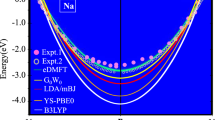Abstract
The surface energies of the low-index surfaces of the 4d transition metals were calculated using density-functional theory and the full-potential linear muffin-tin orbital method. The results are discussed in the context of bound-cutting models. It is found that the usual approach, which ignores the decrease of the bond strength with increasing coordination number, is incompatible with the calculated results. The coordination number — bond strength relation was calculated explicitly for several metals, showing that the bond strength decreases roughly as the reciprocal of the square-root of the coordination number. A modified model which takes this into account correctly describes the magnitude and the surface depencence of the calculated surface energies. In addition, we discuss the previously ignored role of the free-atom orbital structure in bond-cutting models.
Similar content being viewed by others
References
W.R. Tyson, W.A. Miller: Surf. Sci. 62, 267 (1977)
D. McLachlan: Act. Met. 5, 111 (1975)
S.H. Overbury, P.A. Bertrand, G.A. Somerjai: Chem. Rev. 75, 547 (1975)
A.S. Skapski: J. Chem. Phys. 16, 389 (1948)
R.A. Oriani: J. Chem. Phys. 18, 575 (1950)
R.A. Swalin: Thermodynamics of Solids (Wiley, New York 1963)
L.Z. Mezey, J. Giber: Jpn. J. Appl. Phys. 21, 1569 (1982)
I.J. Robertson, M.C. Payne, V. Heine: Europhys. Lett. 15, 301 (1991)
J.P. Perdew, A. Zunger: Phys. Rev. B 23, 5048 (1981). The spin-polarization energy of the free atoms was obtained from separate calculations of the polarized and non-polarized free atoms using the exchange-correlation potential of
S.H. Vosko, L. Wilk, M. Nusair: Can. J. Phys. 48, 1200 (1980)
M. Methfessel: Phys. Rev. B 38, 1537 (1988)
M. Methfessel, C.O. Rodriguez, O.K. Andersen: Phys. Rev. B 40, 2009 (1989)
M. Methfessel, D. Hennig, M. Scheffler: Phys. Rev. B 46, 4816 (1992)
L. Pauling: J. Amer. Chem. Soc. 53, 1367 (1931)
V. Heine: Solid State Phys. 35, 80 (1980)
M. Lannoo, P. Friedel: Atomic and Electronic Structure of Surfaces Springer Ser. Surf. Sci., Vol. 16 (Springer, Berlin, Heidelberg 1991)
V.L. Moruzzi, J.F. Janak, A.R. Williams: Calculated Electronic Properties of Metals (Pergamon, New York 1978)
F. Cyrot-Lackmann: J. Phys. Chem. Solids 29, 1235 (1968)
Liquid metal densities and heats of vaporization from Handbook of Chemistry and Physics, 55th edn., pp. B-235, D-56; surface energies are representative values from ibid. 67th edn., p. F-20. The molar surface area was calculated using a geometrical factor of 1.09 for fcc and hcp, 1.12 for bcc, and 1.14 for others (see [3])
Author information
Authors and Affiliations
Rights and permissions
About this article
Cite this article
Methfessel, M., Hennig, D. & Scheffler, M. Calculated surface energies of the 4d transition metals: A study of bond-cutting models. Appl. Phys. A 55, 442–448 (1992). https://doi.org/10.1007/BF00348331
Received:
Accepted:
Issue Date:
DOI: https://doi.org/10.1007/BF00348331




